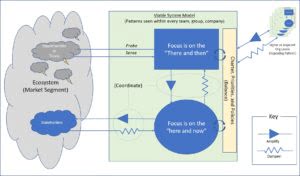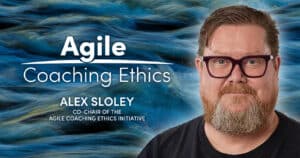I am a strong believer that sound organizational models are the key to a company’s success and its viability in the complex world in which it must survive.
The key to any viable system, much like human systems, is the ability to restructure, evolve, or undergo exaptation to remain viable.
In the case of companies, the key ingredients in the organizational design are sometimes lost and the structures that are created don’t meet the test of a viable system. This leaves it prone to avoidable mishaps and loss and makes it slow to respond to change when needed.
What is a viable system
Back in 1972, Stafford Beer published a model called the Viable Systems Model (VSM). His focus was on applying cybernetics to the management of companies, and this work became the foundation for most of my thinking around how to build adaptive and cunning organizational structures which are the key to business agility.
A viable organizational system, as defined in Beer’s work, is fractal and recursive in nature. In fact, traditional hierarchies that you may work in today are fractal. First level teams typically report into higher-level teams that span out in size to accomplish something larger that can’t be done by just one team. Each staff has at least one person, typically a manager, who is responsible for consolidating status and taking direction from the next higher-up structure. The lowest level teams in the hierarchy are responsible for direct delivery of customer value and the highest is responsible for more of the strategic direction of all the teams under it. Aside from different responsibilities, they all relatively look the same regardless of what team you join.
Fractal is only one part that makes the organizational system viable. A VSM team is tightly coupled to stakeholders and the ecosystem/market segment it is maneuvering within. The VSM calls out a set of common subsystems that each team implements to accomplish the delivery of value to its stakeholders. This includes subsystems that accomplish the daily value delivery, balance what is needed today versus what is needed in the future, amplify and dampen goals depending on ecosystem needs, and strategically identify threats and opportunities in the ecosystem it is focused on. This combination of subsystems gives each team a greater level of concentration and situational awareness, thus tooling it to be able to maneuver independently and interdependently within its charter.
This is the overall structure of a VSM that makes up each individual team. These teams can be combined to make up a group, division, or company depending on the needs. Before talking about that aspect, let’s explore the key heuristics/patterns that make up each team.
The subsystem patterns of a VSM
Viable subsystem patterns are something that we see within each team in an organization. So whether I am looking at a first level team or the executive office, they all behave as a viable system. The only difference would be that the first level team is focused on a small part of the larger delivery and the executive office is focused on a larger portfolio of products that include that first level team. The following diagram breaks down the patterns that make up a viable system:

The first subsystem handles the “here and now.” In other words, this is where the tactical value delivery to the stakeholders happens. This is the part of your team, regardless of delivery method, that is amplifying the delivery of things that stakeholders need while dampening the delivery of things that don’t.
The second subsystem handles the “there and then.” This is the strategic subsystem that is looking further down the road to identify threats that could slow down the first subsystem. Things like running out of resources, missing skills, or maybe competitive threats. It also looks for opportunities that can be exploited in the future, or to possibly pivot to, if they offer a higher return on investment.
The next key system coordinates between the first two systems. For example, the tactical system is focused on the overall daily value being delivered to the stakeholders, but, because of this focus, they may be blind to risks or other potential threats when performing that delivery. The strategic system is periodically probing the ecosystem looking for threats and amplifying concerns to the tactical system in order to mitigate those risks. Also, the tactical system is continuously updating the strategic system on things impacting or accelerating the delivery. It also provides critical stakeholders feedback that can be used to maneuver the team to the most viable area in the ecosystem to deliver overall higher value.
Viability and resilience are built with each team having internal systems that balance and coordinate the “here and now” with the “there and then.” The last key system is balancing the strategic system with the tactical system to the purposes, priorities, and policies of the team, group, or entire company. The team’s charter gives the team focus and is the key to keeping things in balance. All decisions are balanced against the charter. For example, if an opportunity is found but it is not within the focus of the team it may decide to amplify that opportunity to a unit that does have that focus. It could also expand, pivot, evolve, or undergo exaptation to swarm on better opportunities as the market shifts or matures.
Applying VSM in your company
Most organizations have a majority of the VSM subsystems present within their company but have split the subsystem across their hierarchy. A team in this model may be only focused on the “here and now,” and other teams may be responsible for the other VSM subsystems. No single team is a viable system on its own and cannot work independently to complete its charter. This creates waste and slows the agility of the teams.
Applying VSM is about creating independent teams that can be easily linked together to accomplish a larger goal. Getting existing teams to behave as viable systems is not really that hard and does not require additional resources. It just takes a bit of work to clarify charter and roles while implementing the VSM patterns.
For the past decade, I have built my teams with the VSM patterns. If the team had a small charter and focus, the responsibilities of the manager are focused on the “there and then” while the members of the delivery team are focused on the “here and now,” and as a staff run processes to ensure coordination and balance. In larger systems, one member of the team would also be responsible for the balance and coordination with other adjacent or higher-level teams. Delivery of larger solutions typically links teams in a hierarchy with a common high-level charter where each delivers an ingredient into a larger solution.
In all cases, each team, regardless of level, is interacting and gathering knowledge about the ecosystem market. So it is important to implement ways of capturing and sharing the insights and knowledge of the teams, making it easier to see market trends and to recharter and shift teams to a place of higher value as needed.
Structured for cunning business agility
With these organizational patterns in place in all teams within your company, you are enabling a higher level of business agility or cunning agility. Cunning because the viable system you built can think in both the “here and now” while looking ahead strategically for opportunities and threats. Agile because the systems allow you to adapt to your stakeholders’ needs and easily assemble groups of viable systems to take on greater opportunities.
Stafford Beer’s Viable System Model is by no means the only organizational model you can use. I find it to be the one that I keep in mind as I am doing organizational design due to its capabilities. The key point to remember is that this group of patterns makes it easier to reorganize, grow, shrink, etc. It is also patterned after how we as humans have remained viable for 200,000 years. Making each level of your company a viable system—delivering, learning, and adapting to build a successful company.
Supporting Agile Adoption Workgroup and the Agile Coaching Network
This article is based on the discussions of the Agile Alliance Supporting Agile Adoption Workgroup. I want to thank Hendrik Esser, Jutta Eckstein, Eric Abelen, Bjarte Bogsnes, Jen Coldewy, Marcin Floryan, John Buck, and Elena Vassilieva for their challenging insights. If you would like to hear part of our conversation about organizational design, you are welcome to listen to a special edition of the Agile Coaching Network (ACN) podcast.











